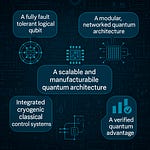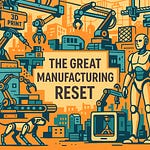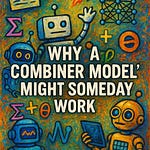Thank you for tuning in to this audio only podcast presentation. This is week 198 of the Lindahl Letter publication. A new edition arrives every Friday. This week the topic under consideration for the Lindahl Letter is, “Machines that build machines.”
As we embarked on this new season of the Lindahl Letter, I signaled that we would focus on three content themes. These themes included quantum computing, machines building machines, and agents taking action. We are now shifting from quantum related topics toward innovations in advanced robotics, which I group under a series of research notes titled “machines that build machines.” The future of manufacturing depends on more than automation. It hinges on the ability to rapidly prototype, iterate, and deploy the machines that make everything else possible.
Modern manufacturing at scale nearly always involves some form of robotics. These robotic systems range from industrial arms performing repetitive tasks to highly customized modular assemblies tailored to the needs of specific products. A few weeks ago, during our trip back to Kansas City, I listened to the audiobook Apple in China by Patrick McGee [1]. That narrative presented a vivid exploration of Apple’s entanglement with China’s manufacturing infrastructure. Beneath McGee’s primary story is a powerful subtext about the foundation of China’s manufacturing prowess. The critical enabler in that story is the set of machines that build other machines. These tools not only support prototyping and product assembly but also underpin supply chain resilience and adaptability. A nation’s or company’s ability to design, iterate, and build these enabling machines directly influences how quickly it can scale production, respond to demand, and recover from disruption.
To refine this research note further, I want to focus on the prerequisites for developing these prototyping machines. What infrastructure, talent, and technological components are essential to make all of this work going forward. Unlocking these prerequisites will be key. It likely starts with a feedback loop between design software, materials science, and precision engineering. You need high-accuracy CNC tools, industrial-grade 3D printers, flexible robotic arms, and a digital design plus rapid testing environment that allows for fast iteration. Integration with simulation software enables virtual testing before physical builds. On top of that, you need skilled operators with interdisciplinary knowledge across mechanical design, embedded systems, control theory, and software development. Building machines that build machines is not just about automation. It's about compressing the distance between what can be imagined and what can be executed.
The engineering talent capable of achieving this is increasingly interdisciplinary. My thought here is that clusters of skilled workers in this space have a distinct advantage. Based on my initial research you can find clusters in five primary regions in the United States. Boston and Cambridge are anchored by MIT and home to legacy firms like Boston Dynamics [2]. Silicon Valley remains a stronghold with a deep pool of venture-backed robotics startups. Pittsburgh leverages Carnegie Mellon University to drive robotic innovation, while Austin, Texas, is rising fast with Tesla’s Gigafactory and a strong embedded systems culture. Here in Colorado, the Denver–Boulder–Fort Collins corridor is building momentum. The University of Colorado Boulder contributes robotics talent, and local companies like AMP Robotics, Ball Aerospace, and Intrinsic (a Google X spinout) are growing engineering teams focused on automation and scalable machine design [3][4]. It’s not the largest cluster, but it’s one with real promise and momentum. It’s the region where I plan on making contributions going forward.
Outside formal clusters, much of the talent exchange is happening in online communities. Hackaday.io is one of the most active hubs for open-source hardware builders. Reddit forums like r/robotics and r/functionalprint allow engineers to share designs and feedback loops. GitHub is where firmware, control systems, and design files live. Especially for foundational projects like GRBL, Klipper, and Marlin [5][6][7]. This is an ecosystem I want to investigate further: what enables it, where it thrives, and how it might be scaled to bring the next generation of prototyping and manufacturing capability into reality.
Things to consider:
1. Manufacturing capability now depends on how fast you can build and reconfigure the machines behind production lines.
2. Engineering talent that enables machine-building clusters around universities, megafactories, and open-source communities.
3. Denver and Boulder are emerging as credible nodes in this ecosystem with strong robotics and aerospace footholds.
4. Online platforms like Hackaday, GitHub, and ROS Discourse are core to knowledge sharing and prototyping workflows.
5. The real unlock may come from compressing time between idea, simulation, prototype, and deployment.
What’s next for the Lindahl Letter? New editions arrive every Friday. If you are still listening at this point and enjoyed this content, then please take a moment and share it with a friend. If you are new to the Lindahl Letter, then please consider subscribing. Make sure to stay curious, stay informed, and enjoy the week ahead!
Footnotes:
[1] Patrick McGee, “Apple in China: The Capture of the World’s Greatest Company”, Scribner, 2025. https://www.simonandschuster.com/books/Apple-in-China/Patrick-McGee/9781668053379
[2] https://bostondynamics.com/industry/manufacturing/
[3] https://ampsortation.com/
[4] https://x.company/projects/intrinsic/
[5] https://github.com/grbl/grbl
[6] https://github.com/Klipper3d/klipper
[7] https://github.com/MarlinFirmware/Marlin











